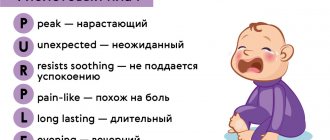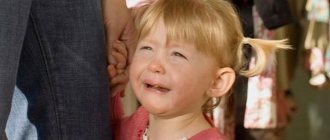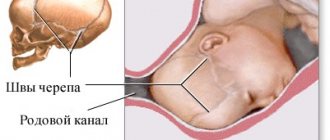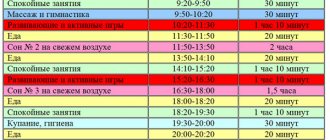For a child who cannot yet speak, crying is the only way to communicate his needs to the outside world. The baby cannot take care of himself and calls his parents for help. The sound of a newborn baby crying should not cause panic. Moms and dads just need to learn to recognize how a child cries, understand the reasons for the roar and promptly eliminate possible causes of his concern.
If a child cries, it means he wants something.
Types of crying
How babies react to the weather - problematic
Experts identify four main types of crying in babies, depending on what it means:
- Satisfaction. Many doctors claim that a baby's cry is an indicator of his health and strength. For a newborn, breathing itself is a new and, to some extent, exciting process. Up to a certain age, babies scream and cry simply because they can physically do it. Often, crying helps an infant feel more confident in restless and alarming moments.
- Pain. The cry of pain cannot be confused with anything. It is loud, harsh and shrill. If the baby has colic, he can press his hand to the sore spot. In some cases, the painful appearance of a baby's crying is associated not with unpleasant sensations, but with their anticipation. For example, a baby may start crying when his mother undresses him. In this case, he fears the deprivation of warmth and the associated feeling of security.
- Anger. The angry crying of a baby is an excellent, albeit unconscious, way of manipulating parents. With such a roar, the baby tries to change a situation that does not suit him. In this case, a crying small child may kick, scratch, or even hold his breath.
- Grief. If anger is a normal reaction to irritation, then with sadness everything is more complicated. By expressing his grief through tears, the child learns to cope with negative life experiences. Don't try to distract or cheer up a crying baby. It will be much more effective to take him in your arms, caress him and show your love.
You can understand a lot by the nature of your baby's crying.
First examination of a newborn
For the first time, the child is examined immediately after his birth. At the same time, it can remain on your stomach, since the first conclusion about its condition is made based on observations. Is he breathing well? Is his skin well supplied with blood, what color is it? How are things going with muscle tone and reflexes? The results of these observations are assessed using the so-called Apgar score.
Apgar score
Almost 50 years ago, the American Virginia Apgar, an anesthesiologist by profession, published a system for assessing the clinical condition of a newborn in the first minutes of life. In this case, five vital functions of the child are assessed in points immediately after birth, and then 5 and 10 minutes later. For each of the five criteria listed on the scale, the doctor can give from 0 to 2 points, that is, the maximum amount is 10 points. If the total is less than 7 points, the child needs intensive monitoring and care.
pH value and maturity test
Blood taken from the umbilical cord is used to determine the pH value to determine whether the baby was oxygen deprived during birth. To make a conclusion about the degree of maturity of the newborn, the Petruss assessment table is used. This takes into account such features as skin (color, formation of folds), nipple (glandular tissue), auricle (formation of cartilage), sole of the foot (striations of the feet) and external genitalia (location of the testicles, labia). Based on the assessment of these signs, a conclusion is made about the maturity or prematurity of the child.
The pediatrician will carefully observe how active the child is, how he moves and how he reacts to stimuli. He or she will listen carefully to the newborn's heart sounds and lung sounds, and examine him for possible defects, such as a cleft palate or birth injuries. Based on the results of this first examination, the pediatrician will determine whether the child requires emergency medical care.
pH value
The pH indicator indicates the oxygen saturation of the blood. With a value below 7.00, serious problems with the child’s adaptation often arise. In this case, it is customary to call a pediatrician and, to avoid risk, place the child in a children's clinic. However, in most children, the pH value returns to normal or begins to approach it within 2 hours after birth.
- A pH value of 7.30 or even higher is optimal.
- The pH value is between 7.12 and 7.29 - normal.
- A pH value below 7.12 is the maximum permissible. value indicating danger of overacidification.
- A pH value below 7.00 is a critical value indicating overacidification.
Prevention of vitamin K deficiency
Following the first examination, the neonatologist carries out prevention of a number of disorders and diseases typical of newborns.
In some countries, 2 mg of vitamin K is required to be instilled into the child's mouth. The newborn receives a second dose after three days.
Vitamin K is extremely important for blood clotting. Its deficiency can, in particular, cause intracranial hemorrhage in a child.
In Russia, such a measure is taken when necessary. If you are unsure about its use, discuss the possible risks of internal bleeding from vitamin K deficiency with your doctor or midwife.
Risk factors for bleeding include long-term use of medications that harm the baby's liver, stress due to cesarean section, pinching, hemorrhage, premature birth or late initiation of breastfeeding.
The drops that are given to the child have an unpleasant taste, so the facial expressions of babies mostly express protest and disgust. It is best to put the baby to the breast immediately after the drops.
Prevention of eye diseases
Eye drops that are instilled into a newborn for preventive purposes protect him from severe infections (for example, gonorrhea).
Finally, the baby will be weighed and his height and head circumference will be measured. The doctor will enter all data into the medical record.
Blood group determination
After the baby is born, blood will be taken to determine its type. In addition, a mandatory blood test will be done to check for the presence of severe genetic diseases (its results will then be sent to the children's clinic).
The necessary examinations of the newborn will not take much time, and the medical staff will try not to interfere with your communication with the child in these first precious hours. Of course, unless you want to rest after a very difficult birth.
To establish a warm relationship between parents and child, direct skin-to-skin contact is best suited.
The baby is first put to the breast in the delivery room. Usually everything works out great, because in the first hours after birth, children are unusually alert and attentive. In difficult cases, a midwife will come to your aid.
Troubling Reasons for Crying
How to use baby powder
The sound of a baby's cry will vary. It can be sharp, monotonous, abrupt, hysterical, etc. Often, discomfort and anxiety are hidden behind the crying of a small child. They can be caused by various reasons.
Hunger
Most often, babies under three months of age cry because they are hungry. It is quite simple to distinguish such a roar by its demand and persistence. In addition, it occurs only after a certain time after the previous feeding. A hungry baby's cry will most likely be accompanied by reaching out of the arms and sucking movements of the mouth. If the tears were caused by hunger, the baby will immediately calm down after feeding.
Most children cry when they want to eat
Fatigue
Babies under three months should normally sleep from 18 to 20 hours. You can tell by the baby's crying and the sound that he is tired. Moreover, the louder and longer the roar, the higher the child’s need for sleep and proper rest.
Important! If your baby is too tired, he may not be able to immediately calm down and fall asleep. A warm bath or being outside in the fresh air can help your child relax.
Pain
Although a baby's cry is considered a normal newborn sound, sometimes tears can be caused by pain. The baby may cut a tooth, develop colic, or develop otitis media. If you suspect a particular painful condition, the baby should definitely be shown to a doctor, who will determine what exactly is causing concern in the child and prescribe adequate treatment.
Important! You should definitely seek medical help if the baby’s crying is monotonous and practically never stops, and the baby himself looks lethargic and apathetic.
Physical discomfort
Sometimes a crying child tries to show his parents that he is uncomfortable: he is cold or, on the contrary, dressed too warmly. Thermoregulation in infants is not yet fully developed, and they feel especially acutely both overheating and hypothermia.
When a baby is hot, he sweats and his skin turns red. If you do not remove excess clothing from the baby or move him to a cooler place, it will be impossible to avoid the loud and heart-rending crying of the newborn.
If a child is cold, the first thing he does is get cold hands and feet, and he starts screaming and whining. In most cases, crying during hypothermia is accompanied by hiccups.
Unpleasant taste of milk
When a baby cries while eating, many mothers blame teething. In fact, this is not always the reason. A crying baby may simply find the taste of mother's milk unpleasant. This can happen for one of the following reasons:
- maternal consumption of smoked, hot or spicy foods;
- changes in the mother’s hormonal levels due to stress (negatively affects the quality of milk);
- intense physical activity of the mother;
- taking medications (some);
- the first manifestations of mastitis or lactostasis in the mother (these diseases make milk salty).
Crying as an indicator of a baby's mental development in the first months of life
“Questions of Psychology”. 1993, No. 3, pp. 17–23.
Author: N.Ya. Kushnir
An analysis of theoretical and experimental literature shows that “crying” forms of child behavior are the subject of research by many scientists in the field of psychology, psycholinguistics, physiology, and pediatrics. In this regard, we have identified the main directions of research into children's crying. These include: 1) crying as a structural component of the child’s emotional sphere, which is a manifestation of a negative emotional reaction (expressive function), 2) crying as a means of communication with adults (communicative function), 3) crying as a factor of interaction in which there is a coincidence of motives or their disunity (interactive function), 4) crying as a pre-speech structure of the preverbal period of speech development, 5) crying as a physiological mechanism of speech, the initial component of which is the intonation structure of crying [8].
In psychology, emotions are usually understood as a unique form of reflection of reality, which expresses a person’s subjective attitude to the world and to himself. Emotions in humans are associated with all types of vital activity of the body. With emotions, the activity of internal organs changes: breathing, blood circulation, digestion; changes are observed in facial expression, posture and movements of the whole body, in intonation and timbre of the voice. In other words, the structure of emotional manifestations includes neurophysiological and motor-expressive components and their subjective experience. Therefore, the emotions of young children are considered either as one of the forms of child behavior or as a functional system.
From the point of view of the first approach and according to the biological theory of emotions, they are divided into positive and negative. Positive emotional reactions include: a) revival of general movements, b) facial expressions of satisfaction, c) smile, d) laughter; to negative: a) restless movements, characterized by large amplitude and sharpness and usually representing the initial stage of manifestation of other forms of emotional reactions; b) facial expressions of displeasure; c) whining; d) screaming and crying [5], [7], [19], [23].
Ready-made initial forms of expression of negative emotions include the screaming and crying of a newborn child, the cause of which is the dissatisfaction of organic needs: hunger, disruption of food concentration, overexcitation before bed, massive skin irritants, pain, etc. Satisfaction of organic needs relieves emotionally negative reactions, creating favorable preconditions for the emergence of emotionally positive reactions, but in itself does not generate them. Therefore, it is generally accepted that negative emotional reactions are a group of innate emotions that perform a protective, adaptive function and are aimed at satisfaction
18
physiological needs according to the mechanism of conditioned reflex connections. The predominance of negative emotional reactions in the first month of life and the absence of positive ones indicates that the process of developing ways of responding to stimuli from the external and internal environment is taking place. During the newborn period, the process of assimilation of received information occurs at the sensory level: the child learns various methods of action. Consequently, emotional states are characterized by qualitatively and quantitatively different emotional reactions. E.B. Volosova defines four microperiods in the development of a child’s emotional states in the first months of life [2]. Their qualitative analysis showed that the dynamics of emotional states are of a staged nature. If in the first month of life the presence of only negative emotions is established, performing the function of adaptation and defined as a response to environmental influences, then by the end of the first month symptoms of differentiation of various stimuli by quality appear: emotions begin to acquire a selective character. In the second or third months of life, crying, while continuing to perform a physiological function and carrying a negative connotation in combination with the emerging positive emotions, acquires a social character.
The study of the child’s emotional reactions as a functional system has made it possible to establish that the adequacy of emotional reactions to the reasons that cause them is obvious even to the uninitiated, and it is this property of emotions that provides the signaling value of their manifestation as a means of the child receiving everything he needs from an adult. The complexity of the physiological processes that make up emotional reactions is manifested here quite clearly. Thus, a negative emotional reaction when feeding is delayed, expressed in screaming and crying, is manifested in increased general motor activity (restless movements), increased heart rate, characteristic facial expressions of crying (resentment) and vocal sounds with corresponding changes in the respiratory curve (hungry crying). A negative reaction during tight swaddling is expressed in facial expressions of displeasure, a protective reflex of straining as an attempt to free oneself from the restriction of movement, holding one's breath and slowing the pulse (anger reaction). Already at the earliest stages of development, a child is characterized by the functioning of emotional states of different structure, having an active or passive nature and reflecting one or another “mood.” Many researchers note that a child’s crying can not only be caused by reasons of a biological nature, but is also focused on receiving socially significant positive emotions, namely: the need to receive visual and auditory stimuli, the need to communicate with adults, the need to receive generated previous habits (sickness, pacifier, carrying). In a word, the child’s emotional reactions can be evoked or addressed to adults in order to obtain the preferred stimuli offered during the communication process.
Thus, a child’s crying in combination with pantomime performs not only an expressive function as a means of expressing negative emotions, but also a communicative one as a means of transmitting information and establishing contact with the environment. A.I. Sorokina notes in her research the need to identify the role of negative emotions as communicative means in the mental development of a child [19]. An approach to solving this issue in theoretical terms is possible from the standpoint of the concept of the genesis of communication developed by M.I. Lisina and her staff. The most important provisions regarding the role of emotions in communication are expressed in the following facts.
Satisfying the need for communication causes positive emotions in the baby, and they also become the first
19
means of communication, participating in it as situational emotions in the form of a reaction to the changing conditions of communication and as proactive manifestations addressed to an adult in order to prolong or modify communication. What is the role of negative emotions? During the newborn period, emotions perform the function of assessing motivation and regulating the child’s behavior in the sphere of satisfying organic needs. In this case, only negative emotions perform an expressive function. Screams, facial expressions, movements of the child’s limbs and body objectively become signals for the adult caring for him, but subjectively all the child’s manifestations remain involuntary and serve only as an accompaniment to his states [9] - [11]. M.I. Lisina points out that already in the first days of life, a child learns to effectively use adults to eliminate discomfort and get what he needs, with the help of a variety of screams, whimpers, grimaces, and amorphous movements that take over his entire body. The mother or her substitute quickly learns to recognize by the nature of these and other signals what the child wants and how urgently he needs it: they come to the rescue in time, and the child receives satisfaction.
In the second month, priority goes to positive emotions: they encourage the child to communicate and perform a communicative function, which leads to the development of appropriate expressions. Negative emotions, while continuing to perform the natural functions of evaluation and motivation in communication, are a reaction to the dissatisfaction of the need for communication, and communication itself proceeds on positive emotions. Thus, a child’s crying performs a double function: first a conditioned reflex, responsive, protective, adaptive, and then an instrumental, proactive, adult-oriented one. This means that in the development of communication, the child first assimilates communicative means and operations, after which the latter are filled with internal content, and on their basis an action is born - a full-fledged communicative act [18].
So, if on the basis of positive emotions in the form of a “revival complex” the communication between mother and child proceeds, then negative emotions (crying) are just a means to attract an adult to communication or to resume it in case of termination. As I. Ranschburg and P. Popper point out, a baby’s smile and cry are an interacting emotional system, in which crying means “come here,” and a smile asks, as it were, “don’t go” [18]. If a smile serves as a tool for establishing the baby’s interaction with people around him (with its help, the child makes himself known about himself and his pleasant feelings to a close adult), then with a cry he not only informs about his state of discomfort, but also communicates his desire to communicate with his mother. Moreover, as empirical data from a number of studies show, a child’s cry is also informative in content. There are crying-complaint, crying-demand, crying-whim, crying-discontent, anger, protest [4], [13], [17]. Depending on the age of the child and the situation of interaction, each type of crying carries a different meaning. For example, crying-demand can be aimed at satisfying the need for food, as well as at the child’s demand for communication with him. Crying protest, expressing dissatisfaction, can be caused by a state of discomfort, tight swaddling, or a protest against the mother leaving his crib. Consequently, a child’s cry, like a smile, becomes a means of communication with adults. M.I. Lisina writes that “in the course of functioning, a child is born and over time increasingly intensifies the need to distinguish an adult as a special object in the world around him: after all, this object is the source of the benefits the child needs, and the effectiveness of obtaining the latter increases greatly when the child learns to “see” and “hear” an object, determine its proximity in space” [11; 7]. Thanks to multiple
20
Through the interaction of the child with the mother in various situations, the infant develops certain forms of behavior, which in the first month should be considered as an “asymmetrical” relationship between an adult and a newborn, and in the second month - as the emergence of a relationship. This happens because the adult treats the child from the very beginning as a subject: he talks to him, praises him, acts and is responsible for him, giving meaning to the child’s facial and vocal manifestations as supposedly full-fledged, expressive, communicative operations [11], [12]. ].
The behavior of adults in interaction with a child is a leading, developing factor in the level of his mental development and the formation of his communication activity and need for communication. Moreover, as noted by M.I. Lisin, activity is slightly ahead of the need: first, the adult includes the child in various types of activities, in which he learns the first connections of the mother-child dyad, and then what is acquired turns into a need, and the child is active to satisfy it. Consequently, the informativeness of emotional manifestations and the content of communicative actions and operations depend on the characteristics of the child’s interaction with adults, which in their structure can be divided into situations of “pure communication”, when the child is physically separated from the adult, and situations of “physical interaction”, in which between the mother and by the child according to tactile, temperature, olfactory, auditory, etc. channels form a biopsychic connection and biopsychic compatibility. Such situations include: playful and emotional interaction with an adult (feeding, waking up, swaddling, bathing, staying awake), independent satisfaction of sensorimotor needs, physical contact (carrying in arms, rocking, etc.). S.Yu. Meshcheryakova notes that interaction situations differ in that each partner takes a certain position in relation to the other, i.e. cyclical activity unfolds between mother and child, in which the behavior of the child and the adult alternately becomes a response to the partner’s interaction, then a new interaction on him [14] - [16].
For example, by breastfeeding a child, the mother satisfies not only the need for food, but also the “sucking need” and the need for bodily contact, through which the temperature, tactile, gustatory, and olfactory sensitivity of the newborn is stimulated. Moreover, she induces in the child those emotional states that she is experiencing at the moment, that is, a communicative act occurs on a subconscious level - the mother conveys an emotional “message” to the child, which he accepts. In a waking situation, when communicative interaction is directly taking place, the mother stimulates various kinds of sensitivity, satisfies affective needs, and creates favorable conditions for the child’s impulsive movements. The baby first gains sensory and affective experience by accepting the adult's actions as messages addressed to him and responding to them accordingly. Then the child's behavior acquires an instrumental character: actions and expressive reactions now become a means of addressing the mother.
M.I. Lisina writes: “The first month is precisely that stage of life when the baby’s initial preparation for contacts with people around him takes place and events occur that are of paramount importance for his entire subsequent development... In addition to organizing an atmosphere of communication, the mother establishes practical “signal connections” with him " The frequent alternation of the baby's movements and the mother's responsive behavior quickly leads to the establishment of actual connections between them. The child develops differentiated ways of expressing some of his needs and states, and the mother learns to correctly decipher them... Starting from
21
in the second month of life, the baby not only perceives the influences of the adult and reacts to them, he gradually also masters the ability to initiate interaction with adults” [11; 42]. The means of proactive, adult-oriented actions of a child in the first months of life can be vocalizations, smiling, motor reactions, and crying. The form of the cry, the time of its manifestation during the day, determined by the child’s need for something, establish the nature of the interaction in the mother-child dyad. The baby's crying performs an interactive function. If its communicative function is associated with the transfer of information, then the interaction function is interpreted as the child’s ability, through crying, to establish the interaction necessary for his physiological and mental development.
E.I. Isenina, who studies the patterns of formation of the preverbal period of speech, identifies a preparatory stage in it, which is of a staged nature. In the first month of life, crying does not yet perform the function of interaction, but only accompanies it. The leading function belongs to the mother, who interprets the child’s behavior as directed and conscious. The more often the mother responds to the baby's crying and satisfies his needs, the sooner the first loud cry is replaced by a specific cry. This means that the child, in the process of interaction, begins to express his desires to the adult; instrumental function develops [6]. This function, according to the author, is formed on the basis of the child’s selective attitude to the speech of an adult, which stands out from a number of other influences. From birth, the child’s interaction with his mother is accompanied by dialogue—proto-conversation. E.I. Isenina writes: “The dialogue between mother and child at this age is unusual: it is a monologue with pauses. Although the baby rarely responds, the mother behaves as if he does. Thus, the baby learns turn-taking in conversation” [6; 13]. According to K. Bateson, by the age of three months a baby can already speak “in turns.” The author suggests that in the process of proto-conversation the baby learns the praxis of speech, the ability to start and end a message, change and interrupt it. This suggests that the process of formation of vocal manifestations begins at birth. If the child’s cry, before the development of the interaction function, only accompanies, but does not express his desires, is innate in nature, then already at three weeks of age it acquires an instrumental character, expressing a certain type of intonation. J. Bruner, in studies on the transformation of an innate cry into an instrumental signal, reports that the initial cry is unstable, without pauses that would indicate an expectation of a response. It has a wide range of audible sound frequencies and, if ignored, ends in an uncontrollable scream or squeal. The more often the mother approaches the baby when he cries, the less he cries in the future and the faster the initial cry is transformed into whimpering pleading vocalizations, stylized and becomes characteristic of the child. This means that crying is filled with content and becomes informative for the mother to understand in combination with non-linguistic means: for example, the actions of the child that he performs in the process of communication (sucks his hand - he wants to eat, twists his legs, presses them to his stomach - his stomach hurts), the previous experience of communicating with the child (mother left - crying), current joint activities with the mother, daily routine (crying before feeding), etc. Therefore, interaction in the mother-child dyad when negative expressive reactions are manifested will be adequate only if the mother is guided by the semantic meaning of the child’s crying, which expresses the subjective emotional state, and by objective data characterizing the interaction situation and determining the causes of the child’s discomfort. The appearance of instrumental crying at the end of the first and beginning of the second month indicates
22
the fact that qualitative changes occur in the child’s psyche. The infant’s behavior begins to focus on the expected result. With the help of crying, the child forces the parents to act in the way they want. E.V. Chudinova writes about this: “A newborn expresses its negative state by screaming. By satisfying the baby's needs, the mother thereby materializes his needs. Thus, the role of a cry in the first months of life is to signal a negative state: the cry actualizes the interaction in the dyad. For the mother, the process of establishing a new system of motives is expressed in the acquisition of objects with which she satisfies the needs of the child, a motivating force, i.e., in turning them into “really operating” motives. While caring for a child, the mother learns to look at things through his eyes and experience his desires. A cry that signals an unsatisfied need of the baby not only has the character of a demand for the mother, but causes a strong affect in her. Perhaps this is the basis for the psychological mechanism of transforming motives into ones that are actually effective for the mother” [23; 13]. From the above it follows that the crying (cry) of a child is a connecting link in the system of interaction with the mother and performs an interactive function. At the same time, the mother focuses on the intonation contour of crying, endowing it with semantic meaning. In her study of the formation of infants' cries, E.V. Chudinova goes from the situation to crying: she establishes a system of acoustic parameters for a certain type of “crying” forms. She identified typical features of cries with the meaning “wants to eat,” “wants to sleep,” and “wet.” However, it is possible to study a child’s crying, following from the opposite: from the interpretation of the signal meaning of the intonation structure of crying to the interaction situation. If there is a need, need, motives, activity, then there must be an attitude. Numerous studies have found that the interpretation of the causes of crying is based on a description of the content of crying, facial expressions and pantomimes that accompany it, and a number of symptoms specific to a particular situation. For example: “A child usually communicates a feeling of hunger with a sudden cry. Sometimes he increases his screaming to frantic crying. At the same time, the body pounds and the child stretches out his hands in front of him. Often the face becomes completely red. The nature of a child’s crying is different if he is tightly swaddled: the baby begins to whine, if the cause of the displeasure is not quickly eliminated, then the whimpering turns into crying of protest.
If a child is bored, then he usually expresses his dissatisfaction about this by whining or screaming “at the top of his lungs,” but from a violent cry he suddenly turns into a quiet cry, and after a minute he “complains” again [13; 109].
Based on the description of “crying forms” of behavior, it can be assumed that they have an intonation structure. Research shows that it is studied by the method of spectrographic analysis, the auditory method of expert assessment, the method of analyzing the interdependence of acoustic characteristics that underlie perceived intonation structures, etc. Data from spectrographic and intonation analysis of the cry of newborns showed that it does not yet have cortical control, and its communicative nature is not yet of a strictly linguistic nature. There are no constant, cortex-controlled spherical changes in the resonating cavities in accordance with the spectral characteristics of speech sounds and, accordingly, the characteristics of speech intonation. However, the articulatory apparatus of a newborn is quite prepared to pronounce the sounds of human speech. This is evidenced by the presence in the cry of all resonating areas that take part in the pronunciation of speech sounds, although they are not differentiated and not integrated according to the system of phonemes and the intonation structures of the native language. The neural mechanisms of newborn cry are most likely subcortical
23
character, since screaming is an indicator of the biological state of the body. However, newborns have such prerequisites for the subsequent formation of connections of the second signaling system.
Research by R.V. Tonkova-Yampolskaya show that already in the cry of a newborn there is a primary intonation structure. The initial intonation characteristics of a child’s crying are intonations of resentment and dissatisfaction, which coincide with the intonation data of adults. Other types of intonational expressiveness of speech signals are formed on the basis of this primary intonation. In the second month of life, an indifferent intonation appears, which in structure could be compared with the intonation of narration, exhortation (reproach), threat (demandingness) in an adult. Such a qualitative transition in the intonation structure of crying indicates that in the second month of a child’s life, the process of transforming crying as a biological phenomenon - a means of adaptation to the influences of the external and internal environment - into a social one, that is, a means of addressing adults, begins. At the same time, the adult promotes the development of cortical activity of the child’s brain, stimulating the further development of specific speech connections [21], [22].
R.V. Tonkova-Yampolskaya writes that “the primary intonation structure, after an adult’s appropriate response to a cry, acquires communicative meaning in the form of the so-called intonation of dissatisfaction, which no longer changes throughout subsequent life. Intonations of dissatisfaction and resentment remain in an adult basically identical to the primary intonation pattern of a newborn’s cry... To explain how other types of intonations arise from the primary intonation pattern, we must proceed from those forms of speech communication that an adult uses in his communication with a child in the earliest period of his life" [21; 94]. Thus, we are convinced that the process of formation of the intonation structure of crying is carried out by the mechanism of a physiologically inherited system of connections with the surrounding reality. Already in the first months of life, a child has the ability to hear his own cry, which occurs in the same frequency range as the sounds of human speech, and differentiate it into a cry, on the one hand, of pleasure, and on the other, of discomfort. When screaming, the same nerve impulses arise in the organ of hearing as during the perception of speech, and along a specific path these impulses reach the speech-auditory and speech-motor zones of the cortex and from here are transmitted to the organs of articulation. Moreover, as a number of authors note, already in the first months of life, children begin to identify and record the speech influences of surrounding adults among sound stimuli. The child is guided by the phonemic, intonation, rhythmic-structural and timbre composition of the adult’s speech [1], [3], [6]. Therefore, the structure of a child’s cry must have certain parameters, the analysis of which makes it possible to establish adequate interaction in the “child-adult” system.
To summarize the review of scientific data on the problem of children's crying, it can be argued that crying, considered at the psychophysiological level, is interpreted, on the one hand, as a negative reaction and, on the other, as a pre-speech activity of the child. In the first case, crying has an expressive function, thanks to which the child expresses his emotional state using vocal manifestations, facial expressions, and pantomime. In the second case, the intonation structure of crying has a communicative function, through which the child conveys information to the mother about his needs and expresses his attitude towards her actions. Crying becomes socially determined. At the same time, it performs an interactive function, since a process of interaction takes place between mother and child, aimed at objectifying his needs and eliminating the causes causing
24
child's anxiety. Thus, when interpreting a child's cry, three main factors must be considered: expressive, communicative and interactive. Considered together, they make it possible to judge “deplorable forms” of behavior as an indicator of the child’s mental development. This means that, like all mental functions, a child’s crying undergoes qualitative changes depending on age-related characteristics and patterns of his mental development.
- Vetrova V.V. The influence of listening to adult speech on the verbal development of young children: Abstract of thesis. Ph.D. dis. M., 1975.
- Volosova E.B. On the characteristics of emotional states of young children // Problems of periodization of mental development in ontogenesis: abstracts of the All-Union Symposium. M., 1976.
- Godovikova D.B. Features of infants’ reactions to “physical” and “social” sound stimuli // Issues. psychol. 1969. No. 6. P. 79 - 91.
- Zakharov L. The language of crying // Family and school. 1988. No. 1.
- Izard K.E. Human emotions. M., 1981.
- Isenina E.I. Psycholinguistic patterns of speech ontogenesis (literal period): Textbook. Ivanovo, 1983.
- Kistyakovskaya M.Yu. On stimuli that evoke positive emotions in a child in the first months of life // Issues. psychol. 1965. No. 2. P. 129 - 140.
- Kushnir N.Ya. Stage-age dynamics of the intonation structure of a child’s crying in the first months of life: Abstract of thesis. Ph.D. dis. M., 1990.
- Lisina M.I. The emergence and development of direct emotional communication with adults in children in the first half of life // Development of communication in preschool children / Ed. A.V. Zaporozhets, M.I. Lisina. M., 1974
- Lisina M.I. The influence of relationships with close adults on the development of an early child // Issues. psychol. 1961. No. 3. P. 117 - 124.
- Lisina M.I. Raising young children in the family. Kyiv, 1983.
- Lisina M.I., Galiguzova L.N. The formation of children's need to communicate with adults and peers // Research on problems of developmental and pedagogical psychology / Ed. M.I. Lisina. M., 1980.
- Leach P. Infant and child (from birth to five years). M., 1985.
- Meshcheryakova-Zamogilnaya S.Yu. Psychological analysis of the “revitalization complex” in infants: Author's abstract. Ph.D. dis. M., 1979.
- Meshcheryakova S.Yu. On the question of the nature of the “revitalization complex” // Experimental studies on problems of general and educational psychology / Ed. V.N. Pushkin. M., 1975.
- Meshcheryakova S.Yu. Features of the “revitalization complex” in infants when exposed to objects and communicating with adults // Issues. psychol. 1975. No. 5. P. 81 - 99.
- Petrunin V.P., Taran L.N. Cradle of neuroses. M., 1988.
- Ranshburg I., Popper P. Personality secrets. M., 1985.
- Sorokina A.I. Development of emotions in communication with adults in children of the first year of life: Author's abstract. Ph.D. dis. M., 1987.
- Tonkova-Yampolskaya R.V. Development of speech intonation in children of the first two years of life // Issues. psychol. 1968. No. 3. P.94 - 101.
- Tonkova-Yampolskaya R.V. Spectrographic and intonation characteristics of vocal sounds of newborn children. M.; L., 1964.
- Physiology of higher nervous activity of a child / Ed. 3. I. Koralova (Biryukova). M., 1968.
- Chudinova E.V. Development of a baby's cry // Journal. higher nervous activities. 1986. T. 36. Issue. 3.
Natural causes of crying
The child does not sleep well - possible reasons
Natural causes of crying in infants include the following.
Urination
Crying before urinating in young children is not always a sign of the development of some disease. Pediatricians say that the baby begins to cry in order to convey information to adults about his intention to go pee.
A full bladder in newborns causes quite unpleasant sensations, which can also make the child burst into tears. If your baby cries after urinating, he is showing discomfort about being in a wet diaper and wants to be changed.
Defecation
Some parents mistakenly believe that the baby cries before bowel movements because his stomach hurts or he cannot poop. In fact, the roar occurs for a slightly different reason. The act of defecation includes two coordinated processes: tension of the abdominal muscles in order to create intra-abdominal pressure and parallel relaxation of the anal sphincter muscles to ensure the free release of feces. In the first months of life in children, these processes often turn out to be uncoordinated. In other words, the child screams not from pain, but to increase intra-abdominal pressure.
A child's crying during bowel movements is not a symptom of pathology
Teething
In some children, teething occurs almost imperceptibly, in most it is quite painful. Parents need to have a lot of patience to get through this difficult period. When teething, children become very restless, often capricious and cry. The process is often accompanied by an increase in temperature.
While swimming
Most children enjoy bathing. If the baby starts to cry, this means that something went wrong during the procedure. Perhaps the child seems uncomfortable with the temperature of the water or air, he is afraid to be in a bath that is too large, or his parents are simply holding him awkwardly.
An application has been created that analyzes crying
American Ariana Anderson, a mother of many children and a neuropsychologist, invented the ChatterBaby application, which 90% recognizes the cause of children's crying. The application is able to analyze about two thousand variants of infant crying and give the most likely reason.
To create such a strong foundation, Mrs. Anderson, with the help of several mothers, recorded and analyzed audio recordings of children's cries. As a result, the ChatterBaby database they created is able to determine the most likely reasons - hunger, fear, pain, etc. The database is regularly updated by adding new cries to it.
How to determine emotions by crying
By crying, children under one year of age almost never express positive emotions - they are either bored, scared, or in pain. In most cases, eliminating the cause of the discomfort immediately changes the baby’s mood.
If a toddler cries for a long time, and the parents do not react to this, he may develop an inferiority complex. After all, he feels unwanted and abandoned. Changing the situation is simple - just go up to the baby, say a few kind words to him and take him in your arms.
Of course, you shouldn’t panic as soon as tears appear in your child’s eyes. But you need to make sure that everything is okay with the baby immediately, because in some cases crying is a cry for help.
Babies desperately need the attention of their parents
Some young parents believe that through roaring, a newborn baby is trying to manipulate his dad and mom. At such a tender age, the child’s brain is not yet sufficiently developed to implement even minimally insidious plans. The tears and cry of a baby are the language in which he speaks with others until he masters human speech.










